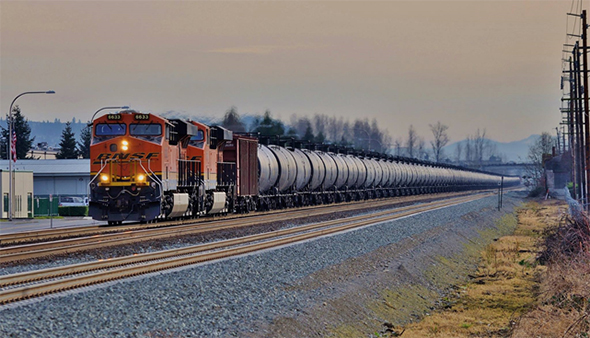
BNSF Railway intends to offer monetary discounts to certain users of tank cars in an effort to boost fleet conversion to the new DOT 117 standard. A solid train of tank cars rolls north along the BNSF through Auburn, Washington on Saturday, January 28th, 2017. Image © 1/2017 by Nikki Burgess; all rights reserved.
The new week brings with it uncertainty over the current regulatory situation. On January 21st, 2017, the newly installed Trump Administration imposed a regulatory freeze on US federal rulemaking. As a result, rules not yet finalized for submission to the Federal Register were placed in hold status; rules which had been finalized but were not yet published were withdrawn for review; rules which had been published but which had not yet reached their stated effective dates were delayed by up to sixty days. The biggest casualty of this action in terms of impact to the shipment of hazardous materials was the HM-215N rulemaking by USDOT/PHMSA. This was the long awaited UN harmonization, which would have matched US law to the most current iteration of the UN Model Regulations (i.e. the 19th Revision). It had been scheduled for publication on January 26th; it is now on hold pending review. In the meantime, things like the new model lithium battery labels and marks adopted by the UN and included in the HM-215N enter a kind of unprecedented “limbo” status in terms of their use in the United States. Fortunately, the lengthy transition periods specified by the UN (up to two years permitted continued use of the older model labels and marks) means that any immediate crisis over shipping does not seem imminent. As of 1/30/2017, when and how this regulatory freeze will be lifted and what its final impact may be is unclear.
Additionally, as this blog went to press on Monday morning (1/30/2017), word came that the President had signed another new executive order that if accurately reported on, will require federal agencies to “cut” two regulations for each new one that they implement, and will require that the cost of any new regulatory action (to the impacted regulated community) is to be offset by cuts in the cost of other regulations. How any of that will or is supposed to work in actual practice remains an open question. See the Reuters story here:
http://www.reuters.com/article/us-usa-trump-regulations-idUSKBN15E1QU
Stay tuned to our blog as we continue to bring you the latest. Meanwhile, there is a smattering of other regulatory news:
PHMSA
In an interesting action in last Wednesday’s Federal Register, there was a request for comments published in reference to a petition concerning the transport of hazardous waste in the State of Oregon, and its status, or not, under the 49 CFR. Interested parties are invited to comment on an application by NORA, an Association of Responsible Recyclers (NORA) for an administrative determination as to whether Federal hazardous material transportation law preempts a hazardous waste regulation of the State of Oregon that imposes a strict liability standard on transporters. Comments received on or before March 10, 2017 and rebuttal comments received on or before April 24, 2017 will be considered before an administrative determination is issued by PHMSA’s Chief Counsel. Rebuttal comments may discuss only those issues raised by comments received during the initial comment period and may not discuss new issues.
In essence the petitioner is asking PHMSA to find the Oregon state hazardous waste rule (which seeks to impose added liability to carriers) too strict and assert federal preemption account the hazardous waste transport regulations in the 49 CFR et al. If PHMSA fails to assert preemption, it may set a precedent that a state could set much higher liability bars for hazardous waste transport—bad news for carriers, certainly, and probably generators too, since this would seemingly disincentivize carriers from serving that market segment—or at the least charging higher rates to generators for transport. One could posit that carrier and generator insurance rates may climb over this as well. If you generate, carry, or ship significant amounts of hazardous waste, this action is one you may wish to watch. Here’s the notice
Rail Tank Car News
The New York Times reported last week that Berkshire-Hathaway owned BNSF Railway, one of the four remaining US Class 1 railroads, will offer bulk shippers of ethanol monetary discounts of up to $300 per car per shipment if they use the newer DOT 117 type cars rather than the older model DOT 111 model cars. DOT 111’s have been involved in a number of major accidents in recent years, and are being phased out in favor of the more sturdily built DOT 117 type cars. BNSF indicates that this is an effort to make faster fleet conversion more attractive to shippers. The railroads face increased insurance and logistics headaches associated with continued use of the DOT 111’s. At press time, the other US Class 1’s: Union Pacific Railroad, Norfolk Southern Railroad, and CSX Transportation, have not indicated that they intend to follow BNSF’s lead. See the Times story here
Labelmaster is a full service provider of products and services for the Hazardous Materials and Dangerous Goods professional, shippers, transport operators, and EH&S providers. See our full line of solutions at www.labelmaster.com.


